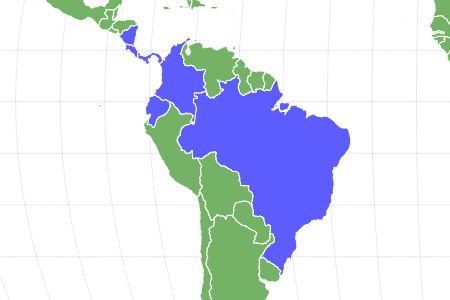Bushmaster Snake
Lachesis sp.
The bushmaster’s scientific name means “silent death.”
Advertisement
Bushmaster Snake Scientific Classification
- Kingdom
- Animalia
- Phylum
- Chordata
- Class
- Reptilia
- Order
- Squamata
- Family
- Viperidae
- Genus
- Lachesis
- Scientific Name
- Lachesis sp.
Read our Complete Guide to Classification of Animals.
Bushmaster Snake Conservation Status
Bushmaster Snake Facts
- Prey
- Small mammals, reptiles, birds, amphibians
- Group Behavior
- Solitary
- Solitary except during mating season
- Fun Fact
- The bushmaster’s scientific name means “silent death.”
- Most Distinctive Feature
- Bead-like markings
- Litter Size
- 5-19 eggs
View all of the Bushmaster Snake images!
The bushmaster snake is the world’s longest pit viper.
The bushmaster is a beautiful snake, large in size, with dark blotches or rhomboids over lighter-colored, often beaded scales, but it is as deadly as it is beautiful. Though its venom may not be as potent as that of other vipers, it can deliver a lot of it through fangs that can be as long as two inches. Not only that, the snake will actually rear up and chase you if you make it mad enough! It is the longest venomous snake in the Western Hemisphere. Read on for more information about the bushmaster.
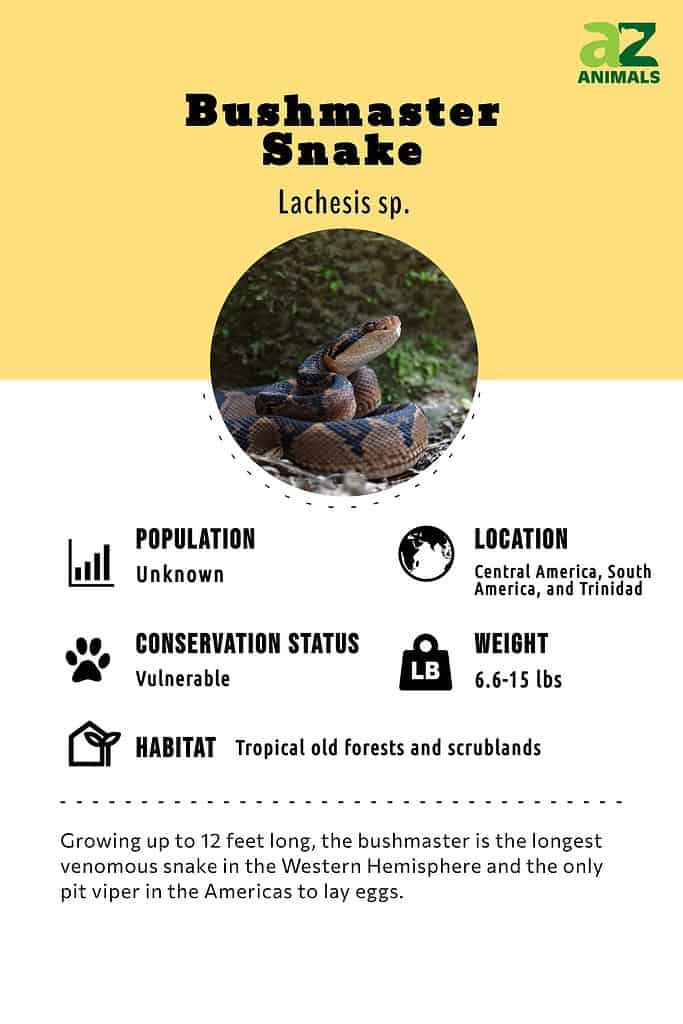
3 Incredible Bushmaster Facts!
Here are three amazing facts about these reptile predators.
- Females lay eggs as opposed to giving live birth, which is unusual for New World pit vipers.
- Its tail ends in a spike that the snake vibrates when it is agitated like a rattlesnake does.
- The snake can strike multiple times at speed and inject lots of venom, which makes it especially dangerous.
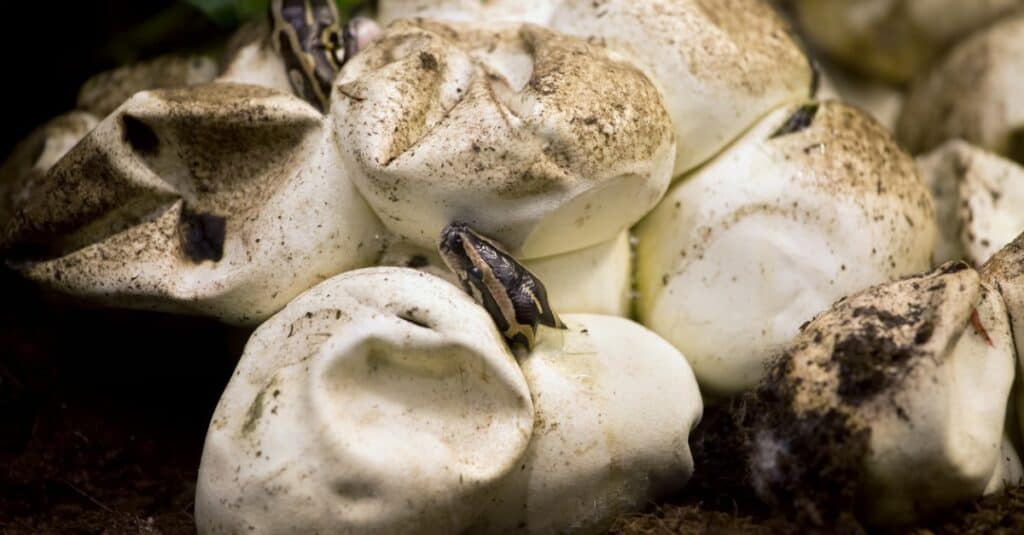
The female bushmaster snake is the only pit viper in the Americas to lay eggs.
©iStock.com/Artur Bogacki
Scientific Name
Bushmaster snakes belong to the Lachesis genus. This genus was named after Lachesis, one of the Three Fates. These were Greek goddesses who spun out, measured, and eventually snipped the thread of a person’s life. Lachesis was the Fate who determined how long life was going to be.
The bushmaster’s scientific name means “silent death.” The South American bushmaster’s scientific name Lachesis muta includes the Latin word for mute in reference to the way the bushmaster moves its tail rapidly when alarmed, much like a rattlesnake — except because the bushmaster has no rattle it is “mute.” (Although this name might be more theoretical as the bushmaster’s rapid movement does make some noise.)
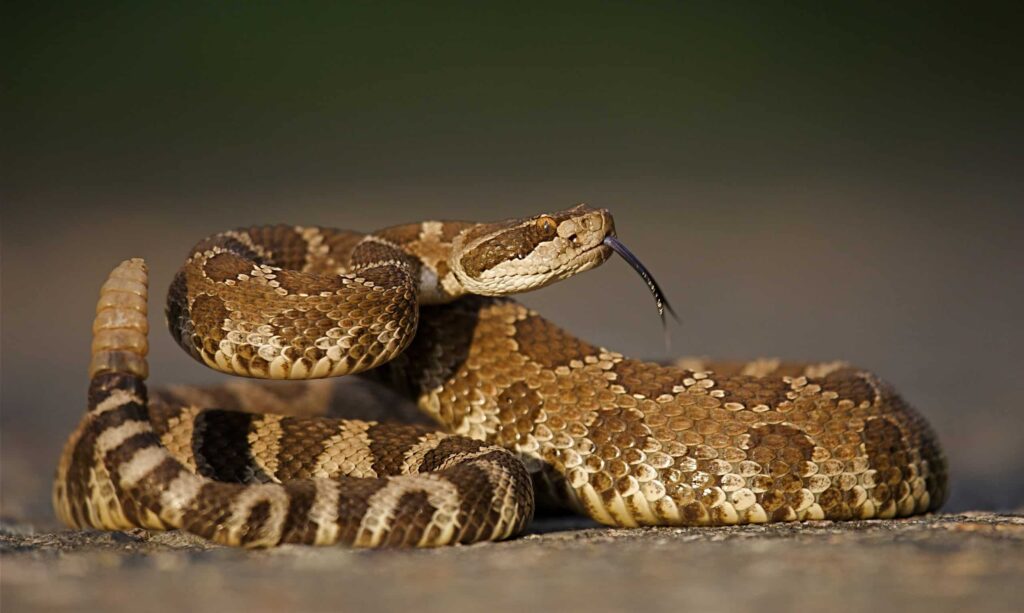
The South American bushmaster’s scientific name refers to the lack of a rattle as seen on rattlesnakes.
©Tom Reichner/Shutterstock.com
Evolution and Origins
These snakes belong to the family of Viperidae and the subfamily of Crotalinae, which consists of venomous pit vipers or pit adders present in Eurasia and the Americas and includes rattlesnakes, lanceheads, and Asian pit vipers. The Crotalinae subfamily is unusual because each species evolved with one characteristic in common: a heat-sensing fossa (a pit) in the loreal region located on each side of the snake’s head between the eyes and nostrils. This pit acts like an infrared heat sensor that allows the snake to locate the body heat of its prey and for its vision to incorporate the infrared spectrum.
The Lachesis genus was previously thought to consist of three species but in 2004 Jonathan A. Campbell and William W. Lamar in “The Venomous Reptiles of the Western Hemisphere” identified a fourth species, the Chocoan bushmaster (Lachesis acrochorda). The Chocoan bushmaster used to be classified as part of the Central American bushmaster (Lachesis stenophrys) species, but it’s thought its evolutionary relationship is closer to the South American bushmaster (Lachesis muta).
The genus also formerly recognized four subspecies, but in the 1980s and 1990s further research by scientists showed two of these — the Central American bushmaster (Lachesis stenophrys) and the black-headed bushmaster (Lachesis melanocephala) — should be considered distinct species due to venom immunological differences and morphological evidence.
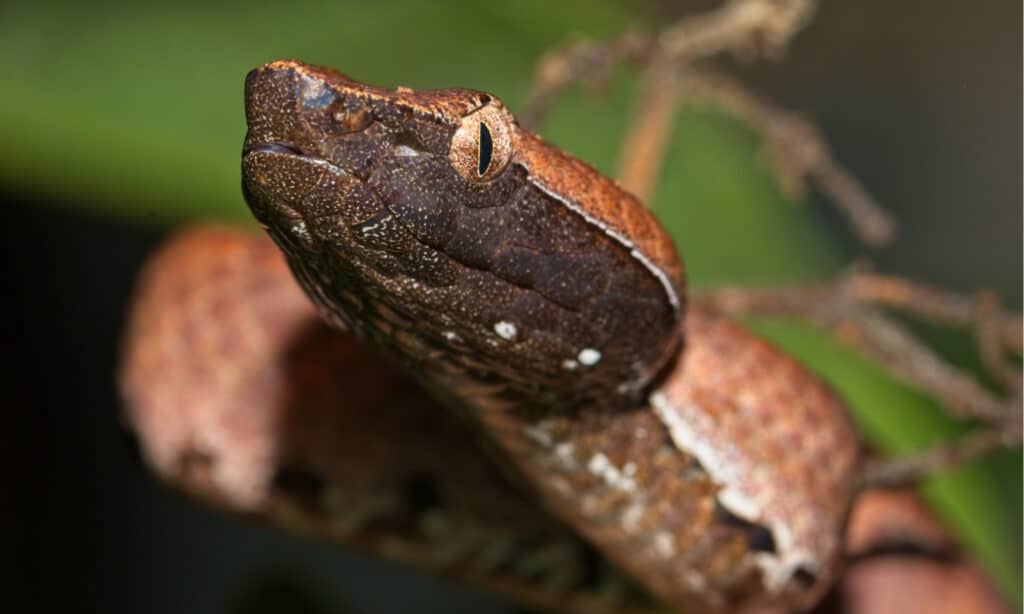
Like its relative, the hump nosed pit viper, the bushmaster snake has a heat-sensing pit behind its nostrils.
©ananth-tp/Shutterstock.com
4 Types of Bushmaster Snakes
There are four accepted species of bushmaster snakes:
- Black-headed bushmaster (Lachesis melanocephala): Named after the black patch on the top of the head, this species lives in the Puntarenas province of Costa Rica. The size of this snake ranges from 7.62 to 6.6 feet, but it can grow as long as 7.9 feet.
- South American bushmaster (Lachesis muta): Also called the Atlantic bushmaster, this snake is found in Trinidad and has two subspecies, including the nominate species. It is the longest venomous snake in the New World and the third-longest venomous snake on the planet. Only the black mamba and the king cobra are longer. This species can be identified by its wide head, round snout, and narrow neck. Its colors are grayish-brown, yellow, or red ground with black or dark brown upside-down triangles or rhomboids with pale interiors on the back.
- Central American bushmaster (Lachesis stenophrys): Once thought to be the same species as L. muta, this snake gets its specific name from the Greek meaning “narrow eyebrow” due to the stripes on the scales behind its eyes. It lives in the tropical rainforests and wet mountain forests of Nicaragua, Panama, and Costa Rica. Its colors are much like those of L. muta.
- Chocoan bushmaster (Lachesis acrochorda): This species used to be thought of as a synonym of Lachesis stenophrys. Called the Chocoan bushmaster because it is found in the Chocó Department of Colombia, it is also present in Panama and northern South America in Ecuador. The snake can be distinguished by the “warty” scales on its belly. It can grow as long as 7.68 feet.
The South American bushmaster has two subspecies:
- L. muta muta: This snake is found in northern South America and Costa Rica, and Trinidad.
- L. muta rhombeata: Known as the Atlantic Forest bushmaster due to its habitat in Brazil’s Atlantic Forest, this snake is the largest in size of the bushmasters and has been known to grow to 12 feet.
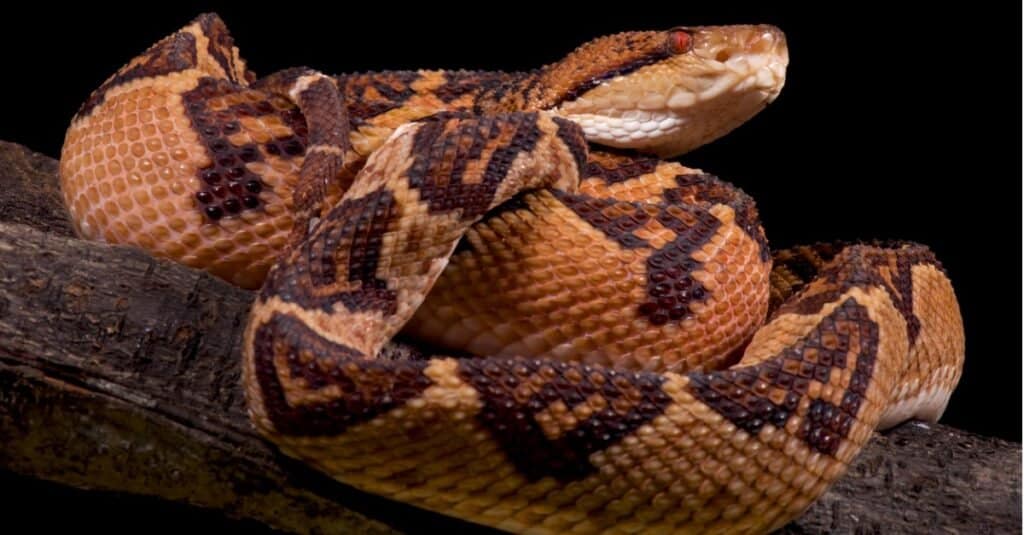
There are four species of bushmaster snakes, each with a black line that runs behind its eyes.
©iStock.com/reptiles4all
Appearance and Description
The bushmaster is a large snake that grows from six to 12 feet and more in length, making it the longest venomous snake in the Americas. On average it weighs around 6.6 to 11 pounds and 15 pounds at most. It has a pattern of dark triangles, diamonds, or rhomboids along its back against a lighter ground of orange, pinkish-tan, or yellow. It has a ridge of dorsal spines down its back. The black stripe that runs behind each eye is found on all of the species and not just L. stenophrys, and the tail ends in a short spike.
The scales of the snake are small and range in texture from almost smooth to tuberculate, which means they resemble beads and contribute to the snake’s overall beauty. Identification of each species is sometimes done by counting the ventral scales. L. stenophrys, for example, has 191 to 209 of these scales, while L. acrochorda has between 202 and 228.
Similar animals are the golden lancehead, cascabel, and fer de lance.
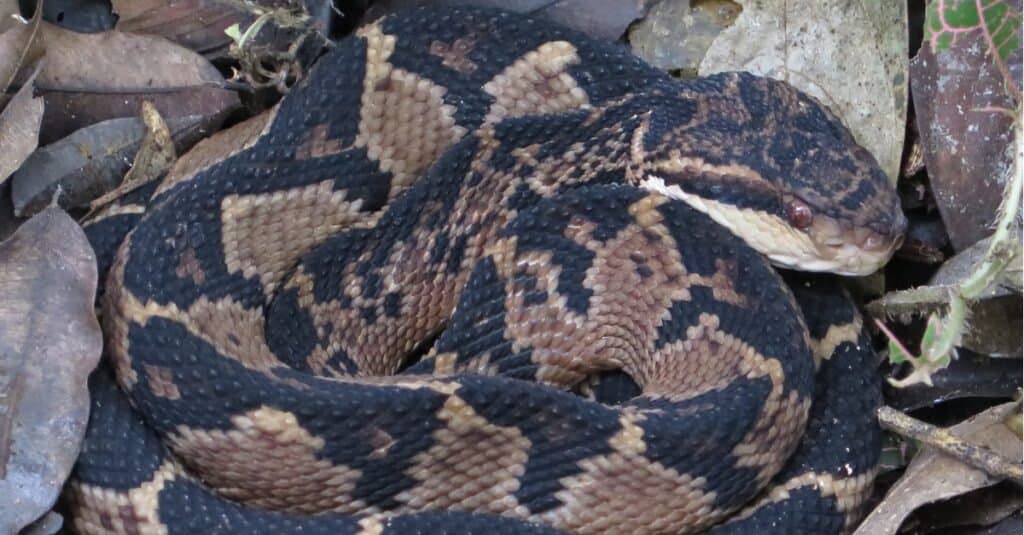
The scales of a bushmaster snake have a smoother texture toward the head.
©iStock.com/Luis Espin
Habitat
The bushmaster snake can be found in Central America, northern South America, and Trinidad.
It prefers a moist, warm, old-growth forest habitat in a location that gives it easy access to fresh water. They mostly live on the ground.
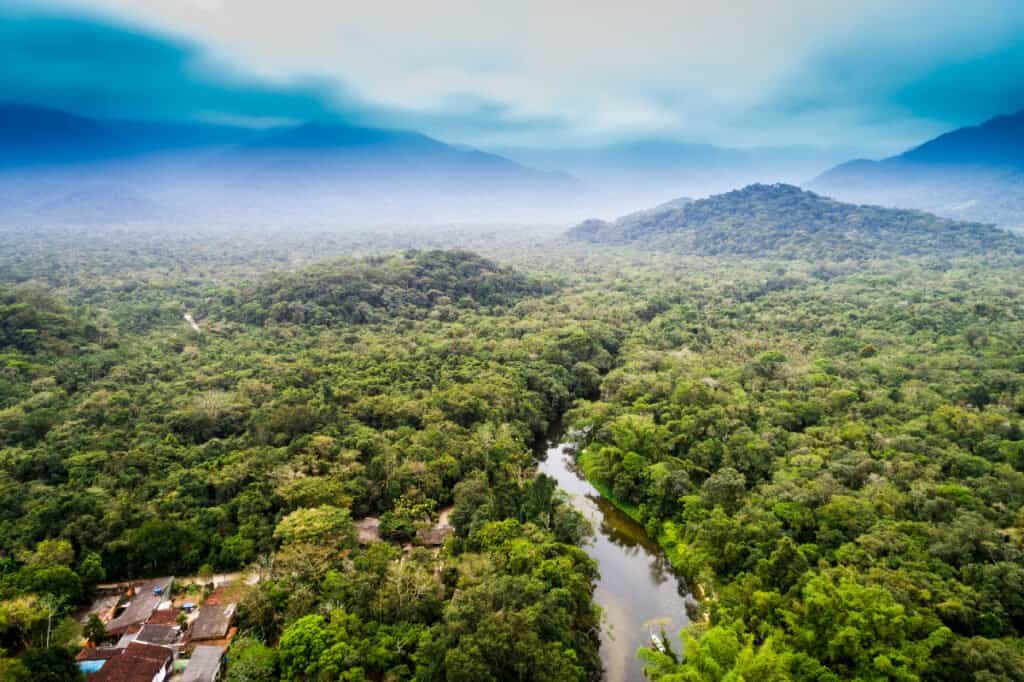
The bushmaster snake prefers habitats with easy access to water.
©iStock.com/gustavofrazao
Behavior
For all their beauty, bushmasters are very dangerous snakes. They bite repeatedly, at great speed, and their bites deliver large amounts of venom that attack both the circulatory and nervous systems. Venom effects are pain and swelling where the person was bitten followed by diarrhea, nausea, vomiting, sweating, slow heartbeat, and abdominal pain. If an antivenin isn’t administered, the person can go into shock, their blood pressure can crash, and they can suffer cardiac arrest.
Like the great majority of snakes, bushmasters are valuable because as predators they keep down the population of rodent pests. Their venom may also have medical uses. Of course, the potency of the snake’s venom and its aggressiveness makes it greatly feared even though it doesn’t kill as many people as the fer de lance.
Which Snake Is More Venomous: The Fer de Lance or Bushmaster?
When it comes to the strength of their venom, the bushmaster has a slight edge on the fer de lance, another snake with impressive fangs. On the other hand, the fer de lance kills more people. Venom effects of a fer de lance bite include nausea and vomiting, headache, necrosis around the bitten area, a rapid heartbeat, and internal and external bleeding. The area around the bite swells up grotesquely. This happens with surprising speed after the person is envenomated. Eventually, the blood pressure crashes, and the person succumbs to kidney failure.
The venom effects of the bushmaster are similar, as it also affects the blood. The bushmaster is potentially more dangerous because it delivers a large amount of venom with each bite and will actually chase after a person who annoys it.

The fer de lance has weaker venom than the bushmaster but it results in more fatalities.
©David Havel/Shutterstock.com
Diet
The bushmaster’s diet is made up of small rodents, birds, amphibians, and other reptiles. The snakes swallow their meals head-first.
It does not chase down its prey but simply finds a location with a large prey animal population and waits for one to walk within striking distance. The bushmaster is able to survive on less than 10 substantial meals a year and can be comfortable spending several weeks at one location waiting to ambush prey.

Bushmaster snakes eat small rodents like vesper rats.
©iStock.com/Alberto Carrera
Predators and Threats
As an adult, this large and venomous snake has few predators save for humans, though juveniles may fall prey to birds of prey or larger snakes.
Reproduction, Babies, and Lifespan
Bushmasters are solitary outside of the breeding season, and they are crepuscular or nocturnal.
Bushmasters can breed all through the year, and females lay eggs, which is unusual for a pit viper. After laying five to 19 eggs in an abandoned burrow, she’ll coil herself around them and defend them. The babies hatch after about 60 to 79 days, and during that time their mother doesn’t eat but may leave the nest to get a drink of water.
The colors of the hatchlings are brighter than those of their parents, and they won’t get the adult livery until they’re about one or two. They’re ready to breed themselves when they’re around four years old.
The lifespan of the snake ranges from 12 to 24 years.

Bushmaster snakes are solitary when not breeding.
©Patrick K. Campbell/Shutterstock.com
Population and Conservation Status
Though the exact number of Lachesis pit vipers is unknown, their conservation status is unassessed by the IUCN Red List. However, some biologists believe these snakes are vulnerable because of the destruction of their habitat.
View all 284 animals that start with BBushmaster Snake FAQs (Frequently Asked Questions)
Are bushmasters venomous?
Bushmasters are quite venomous. Their venom attacks the circulatory and nervous systems and can lead to death if the person isn’t treated.
How do bushmasters hunt?
Bushmasters don’t hunt but wait for prey to come within striking distance.
Are bushmasters aggressive?
Bushmasters can be aggressive, especially if they are defending their eggs.
Where do bushmasters live?
Bushmasters live in Central and South America and Trinidad in the Caribbean.
What do bushmasters eat?
Small mammals, amphibians, birds, and reptiles make up much of the snake’s diet.
How deadly is a bushmaster snake?
The snake is fairly deadly but not as deadly as the fer de lance. Of the 13,044 bushmaster bites between 2001 and 2015, 84 resulted in death.
Will a bushmaster snake chase you?
A bushmaster snake might indeed chase you for some feet if you make it angry.
What happens if you get bit by a bushmaster snake?
If you get bit by a member of the Lachesis genus, call for medical help immediately. Do not apply ice to the location of the bite and do not cut into it or try to suck out the venom though you can try a pump extractor. Apply a constricting band around the limb between the bite and the heart, but make sure not to cut off circulation. Rest the limb below the level of the heart.
What is a bushmaster snake?
It is a large snake that is a member of the Lachesis genus, named after a Fate who determined the length of your lifespan, as the snake is supposed to determine the length of your life after it bites you.
Where does the bushmaster snake live?
These snakes live in the wet, tropical old forest habitats of Trinidad and Central and South America.
What was the largest bushmaster snake ever recorded?
The largest bushmaster ever recorded was 3.65 m (11.98 feet)!
What are the differences between a bushmaster and a Gaboon viper?
The key differences between the bushmaster and the Gaboon viper lie in their size, behavior, hunting style, and family.
Thank you for reading! Have some feedback for us? Contact the AZ Animals editorial team.
Sources
- Wikipedia / Accessed January 22, 2022
- ANYWHERE / Accessed January 22, 2022
- www.repfocus.com / Accessed January 22, 2022
- The Reptile Database / Accessed January 22, 2022
- PubMed.gov / Accessed January 22, 2022
- Los Angeles Zoo / Accessed January 22, 2022
- ScienceDirect / Accessed January 22, 2022

